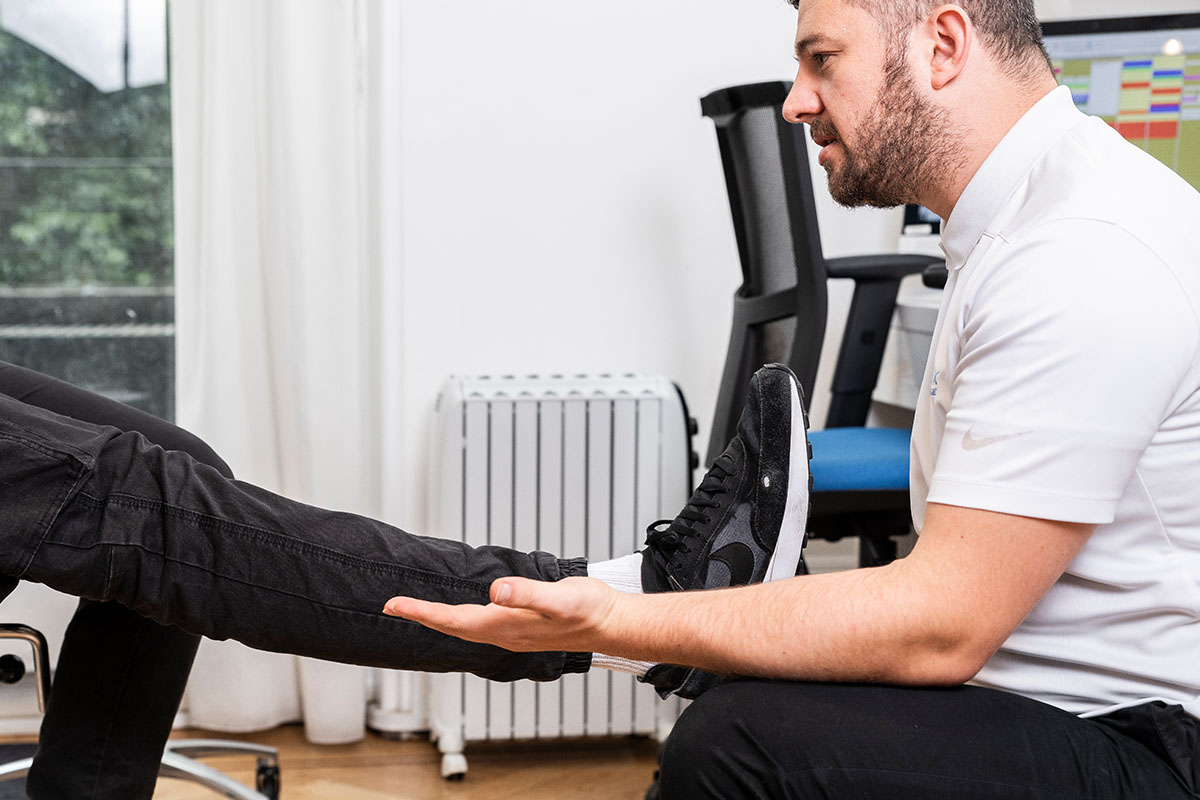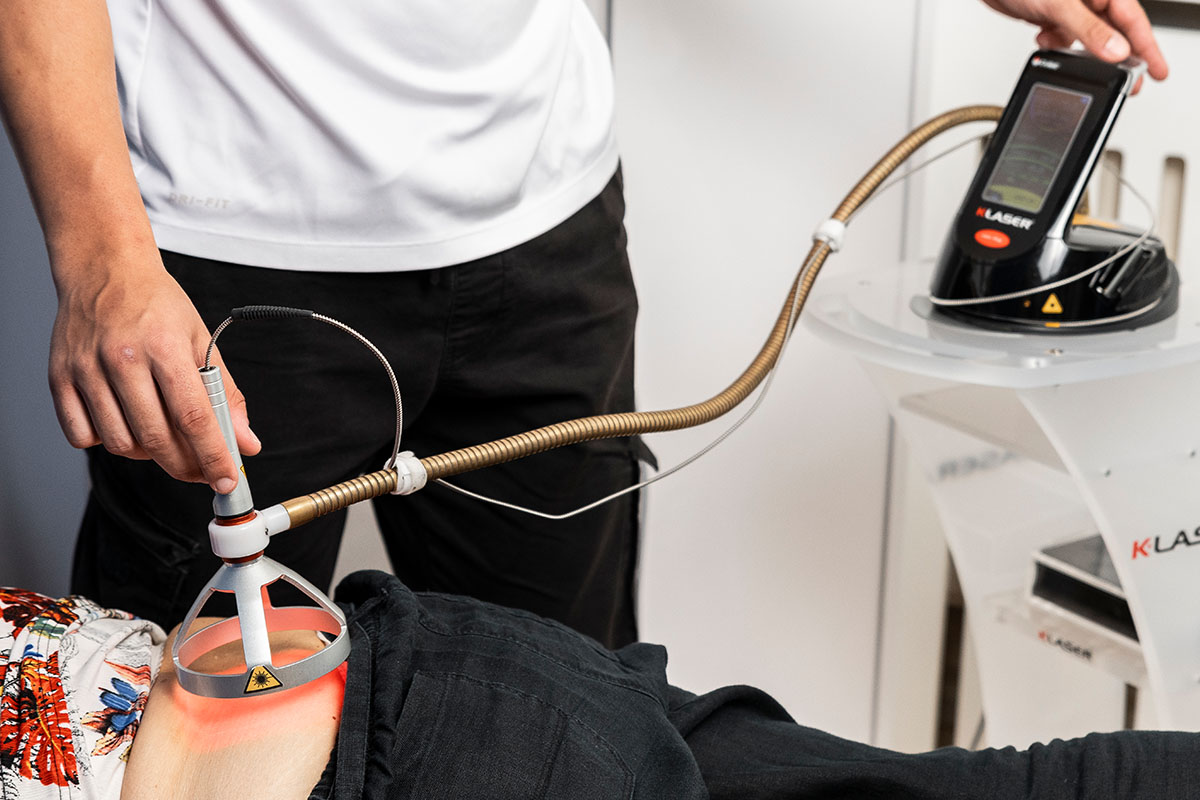
Leg & Calf Pain
Many people live withleg calf painfor months, assuming it will go away. Painkillers may dull discomfort, but they rarely solve the underlying problem. Left untreated, calf pain can become more severe or lead to long-term mobility issues.
At Proback Clinics, we look beyond the symptoms. Using advanced non-surgical treatments such asK-Laser therapy, spinal decompression, shockwave therapy, and Prolozone injections, we target both the source of pain and the surrounding structures to help your body heal properly.
That’s why patients searching for“calf pain treatment London”,“leg calf pain near me”, or“shooting pain in leg specialists UK”often choose Proback Clinics for lasting relief.
Treating Leg & Calf Pain
As Chiropractors, Osteopaths and sports therapists, the ProBack team are responsible for more than just back pain but for the mechanical components of the whole body; how they align and interact is key to understanding how any pain evolves including pain in the leg and pain in the calf.
We see many patients whose leg and calf pain is a direct result of nerve compression within the back known as Sciatica, most commonly this involves shooting pain down the leg often extending into the calf, however sometimes the pain occurs as just calf pain without additional symptoms. Often this occurs as sudden calf pain or can be described as a shooting pain in the calf.
Alternative causes for pain in the leg or calf can be brought on by many different things, with symptoms ranging from mild to severe. Often leg and calf pain is caused by a certain activity or a result of a direct injury without obvious causes, yet there may be a more complicated problem related to a bio-mechanical issue as a result of stresses and strains on the body.
Causes of Leg & Calf Pain
Many causes of leg and calf pain are due to localised inflammation; unless a large and unusual force has been exerted on those tissues, then it is likely that it is a repetitive strain that has caused the issue. In these cases, there are likely to be one or more additional mechanical issues in the chain from lower back to the foot that are causing dysfunction in the muscle tissues. Causes of leg or calf pain can include:
Dropped Arches
Dropped or dysfunctional arches (flat feet) can happen as a result of the arches not forming properly or becoming stiff due to the overwhelming strain caused by walking on hard surfaces like concrete. Local inflammation of tissue in the foot is often known as plantar fasciitis – which we can treat by mobilising the joints in the feet and giving the correct advice on footwear and potentially orthotics.
Muscle Strains
Muscle strains very commonly affect the legs or calves, usually as a result of an excessive force damaging the tendons around joints. If you have a muscle strain you may have swelling or pain in and around the joint area where the muscles connect into the bones; you my experience stiffness in the leg when trying to move the area.
Ankle/Knee Tendinitis
This condition is particularly common in athletes, as the ankle and knee absorb force constantly during strenuous activity. You may get ankle or knee tendinitis as a result of weaker muscles in the legs, for example the hamstrings or thigh muscles, as this puts greater stress and strain on the knee and ankle.
Baker’s Cyst
Baker’s Cysts commonly occur from arthritis in the knee or from a sports injury, it is a form of swelling behind the knee. While this can originally cause pain in the knee, if a Baker’s Cyst ruptures this causes swelling and a sharp pain in the calf.
Compartment Syndrome
This condition can affect ‘compartments’ in the body, for example the leg or arm, and usually happens because of a sudden trauma, like a road accident. Trauma can result in bleeding and swelling within the muscles and can cause symptoms such as severe pain, tenderness or tightness. While acute compartment syndrome may need surgical intervention, chronic compartment syndrome can cause cramping or swelling during exercise which can improve with rest.
Shin Splints
Shin splints can, again, occur as a result of injury from exercise as a result of more intense weight bearing on the legs. Examples of intense weight bearing include; running on a hard surface, or rapidly increasing training distances over a short space of time. The pain can vary in severity from a dull ache to more severe pain during exercise and occurs over the shinbone.
Lower back or neck misalignment
Lower back or neck misalignment can cause referred pain into the legs, this can be as a result of overcompensating with the legs during load bearing, or from a disc injury that may be causing symptoms such as sciatica. This can cause sensations such as pain down the back of one or both legs, weakness, tingling or pins and needles.


Symptoms of a Leg or Calf Injury
Leg & calf pain can vary from mild to severe pain and can be constant or intermittent. Listed below are the symptoms to look out for if you have pain in the leg or calf:
- Leg pain
- Leg muscle pain
- Pain in back of calf
- Shooting pain in the leg
- Lower back and leg pain
- Sensations including tingling, pins and needles or weakness
- Swelling
- Associated hip, knee or ankle pain

Our Leg & Calf Pain Treatments
Once the root cause of the Leg & Calf Pain has been found, Proback Practitioners will decide on the best course of treatment and length of treatment utilising a combination of our unique therapies – Laser Therapy, Spinal Decompression & Shockwave Therapy.
- For localised tissue injury in muscle strains or sprains, or inflammation from arthritis Laser Therapy may be the best treatment option. The K-Laser uses light energy to target an area at a deep, cellular level. The energy improves a cell’s ability to heal and regenerate without tissue damage or side effects. This process can also help in the development of blood vessels (neovascularisation) in the area, which increases blood flow and improves the body’s ability to heal.
- For muscle pain, spasms, or pain referred from pelvis, hip, knee or ankle dysfunction, Shockwave Therapy might be the most suitable treatment. Shockwave uses a light tapping motion (percussion) to help stimulate blood flow and break down scar tissue in the injured area and rebalance the joint and muscle dysfunction underlying the injury.
- If the root cause of Leg & Calf Pain is a disc or nerve problem in the lower back, Spinal Decompression is likely to be most effective. Spinal decompression provides gentle traction to the spine in a rhythmic cycle, in order to pump fluid and nutrients slowly back into the disc space. The desired result is a reduction of spinal disc pressure which creates an ideal environment for continued healing even after the treatment time has ended. Spinal decompression can be utilised for disc problems in the neck and low back.

Why Patients Choose Proback for Calf Pain Treatment London
When searching for“calf pain clinic near me”, patients choose Proback Clinics because we provide:
- Same-day and next-day appointments in London Victoria
- Evening and weekend availability
- Over 15 years’ experience treating leg calf pain and sciatica
- A unique combination of therapies under one roof
- A holistic, patient-first approach that avoids unnecessary surgery
Leg & Calf Pain Treatment Near Me – Proback Clinics London
If you’ve been searching for:
- Calf pain treatment London
- Shooting leg pain specialists near me
- Calf muscle pain clinic UK
- Sciatica and nerve-related calf pain London
- Constant pain in lower leg solutions
…then Proback Clinics inLondon Victoriais here to help. Our highly experienced team is ready to guide you from pain to recovery.
FAQs
The most common causes of leg pain are injuries to the muscles, bones or joints. Athletes can be more prone to developing leg pain because of overuse. Conditions such as tendinitis, muscle strains or shin splints can all be caused by repetitive exercise and excessive force from high impact exercises. If leg pain occurs from an unknown cause, it may be as a result of stress or strain from a different area of the body – for example a problem in the lower back or neck.
The K-Laser at ProBack Clinics, uses light energy to target the body at a cellular level. When used on an injured area, or area experiencing chronic pain, it can increase the cell activity and ability to heal without causing adverse side effects or damage to the surrounding tissue. The laser therapy also helps to increase blood flow to the damaged tissue, by allowing the development of blood vessels in the injured area, improving the body’s natural repairing abilities.
Shockwave therapy uses a light, tapping motion (percussion) to help stimulate blood flow to promote healing, break down scar tissue that may have built up in an injured area, and help to restore the normal function of the area. Often patients can see an immediate increase in movement to a treated area, although with repeated treatments this movement will be improved in the long term as the body recovers from an injury.
Use the form below to book a consultation.
Consultation includes examination, x-ray (if required) and results.
We typically reply within 60 minutes during opening hours.
Award-Winning Treatments
Gentle Non-Surgical Chiropractic Therapy
Inside Proback
5 Minutes From London Victoria Station
Use the form below to book a consultation.
Consultation includes examination, x-ray (if required) and results.
We typically reply within 60 minutes during opening hours.
Accreditations



How To Find Us
Flat 4, Evelyn Mansions,
Carlisle Place, Westminster,
London, SW1P 1NH
Opening Times
Weekdays 8.30am - 8pm
Saturday 9am - 3pm

020 7976 6648




























